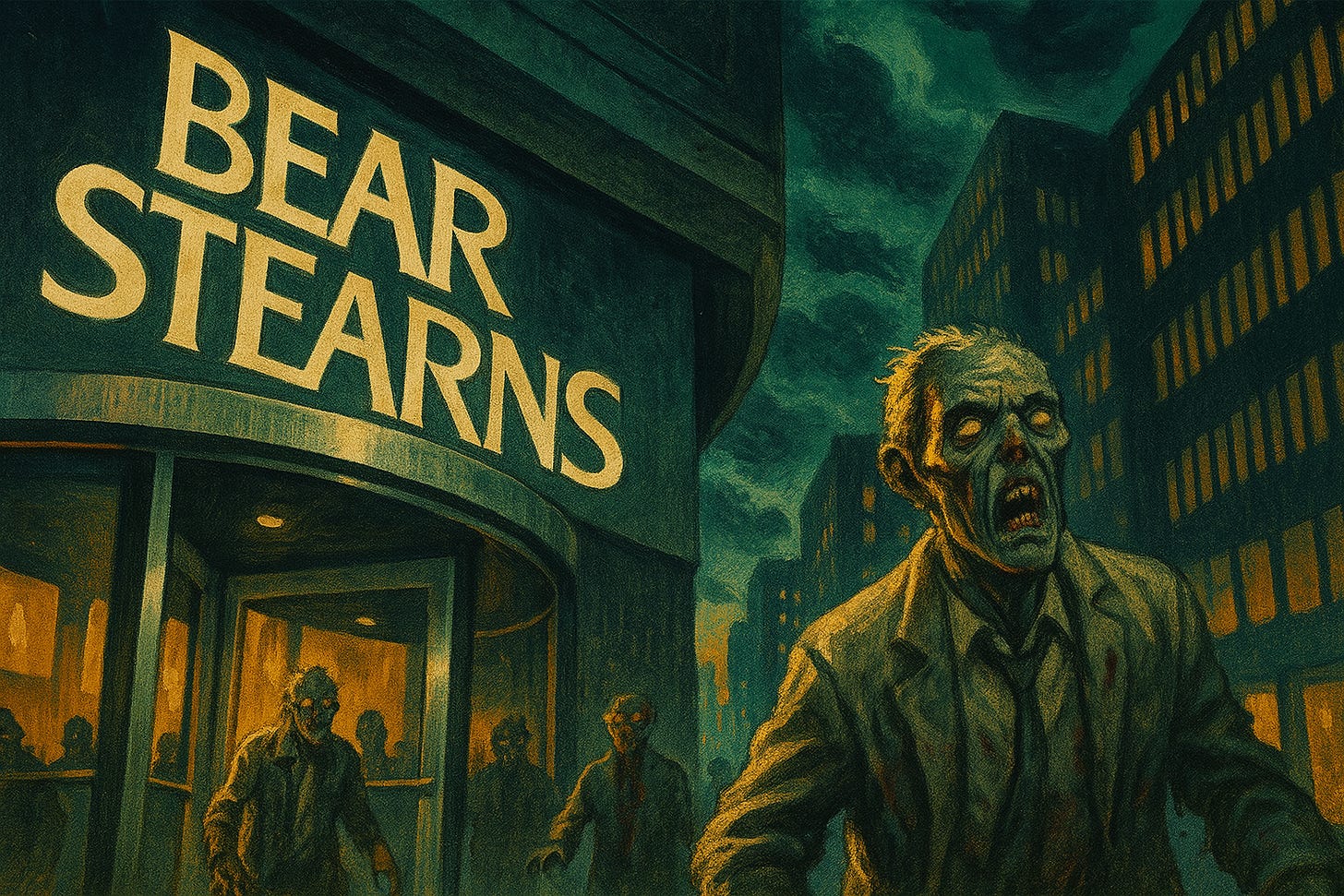🏦🚫 Grifted: Bear Stearns — When One Bank Sneezed and the Economy Caught Pneumonia
🕵️♂️ Grifted: Volume 3
Top of the Series: WorldCom — The Telecom Giant That Billed Us for a Fantasy
Previous: Enron — The Energy Empire Everyone Worshipped (Part II)
🕵️ Grifted: Success That Survives the Scam
Hook:
From Wall Street royalty to fire-sale reject in five days.
Turns out confidence isn’t a business model.
Bear Stearns: When One Bank Sneezed and the Economy Caught Pneumonia
A Practical Field Guide to Business Betrayal
🎯 Series Theme: Grifted
True stories of fraud, failure, and financial fantasy—told not just to entertain, but to equip.
Each installment unpacks how some of the most jaw-dropping business betrayals went down: what insiders believed, what was actually happening behind closed doors, and how you can avoid being the next victim, bystander, or scapegoat.
But this isn’t just a corporate true crime series. It’s a survival guide for professionals who want to lead, build, and invest without getting conned.
🧩 Want to spot the red flags before they crash your career?
📉 Curious how billion-dollar empires crumble in a weekend?
🧠 Ready to build smarter, stronger teams that don’t implode?
Then Grifted is your essential read.
🚨 Stay Sharp. Stay Grift-Free.
Subscribe to Collaborate with Mark on Substack for exclusive drops, extended Grift-o-Meter™ breakdowns, and new stories that go beyond the headlines to reveal the dysfunction lurking beneath the polish.
🆕 Coming Soon:
📘 Collaborate Better: From Silos to Synergy – How to Build Unstoppable Teams
This isn’t theory—it’s your field manual for fixing fractured workplaces, replacing rigid leadership, and building the kind of teams that thrive under pressure.
You’ll laugh, you’ll cringe, and you’ll never look at your org chart the same way again.
👉 Follow now so you don’t miss the next collapse.
Because in business, what you don’t see coming is usually what gets you.

💹 The Rise – “Too Big to Fail” Had Swagger
From a Humble Start to Wall Street’s Inner Circle
Founded in 1923 by Joseph Ainslie Bear, Robert B. Stearns, and Harold Mayer, Bear Stearns began as a modest bond trading firm operating out of a single-room office in New York City. What it lacked in size, it made up for in tenacity. The firm weathered the Great Depression, one of the few to repay its clients in full after the 1929 crash—a move that earned it early credibility. That scrappy survival instinct became a defining trait, as Bear steadily built a reputation for outmaneuvering larger competitors with street smarts and bold, contrarian plays.
The Mavericks Behind the Machine
Over the decades, Bear Stearns cultivated a culture of hustle, loyalty, and relentless ambition. Figures like Alan “Ace” Greenberg—who rose from clerk to CEO in the 1970s—shaped the firm’s ethos. Greenberg famously eschewed Ivy League snobbery, favoring what he called “PSD degrees”—poor, smart, and a deep desire to be rich. His no-frills leadership and intense cost discipline helped Bear expand into investment banking, brokerage, and asset management. By the time Jimmy Cayne took over in the 1990s, Bear was swinging with the heavyweights, and doing it with a cigarette in one hand and a bridge card in the other. Cayne, a brash bridge champion, doubled down on risk and ego, leading the firm with the swagger of a gambler on a hot streak.

From Bond Shop to Big Leagues
By the early 2000s, Bear Stearns was a Wall Street juggernaut. Its specialty? Mortgage-backed securities. While other banks dabbled, Bear went all in—underwriting, trading, and holding massive quantities of complex financial instruments tied to home loans. Their aggressive expansion into these markets turned them into a symbol of Wall Street’s financial engineering prowess. They weren’t just respected; they were feared. Rivals envied their profitability, clients courted their expertise, and insiders believed they had cracked the code of perpetual gain. But as Bear’s footprint grew, so did its blind spots. What looked like genius was often just leverage dressed up as innovation.
By the early 2000s, Bear was a leading player in mortgage-backed securities (MBS). Investors loved its profits. Regulators looked the other way. Bear insiders, riding a wave of housing euphoria, believed their risk models were bulletproof. They weren’t just packaging home loans—they were slicing, dicing, and leveraging them to the hilt.
The myth? That Bear was smarter, faster, and too well-connected to get burned. But confidence isn’t the same as competence. Especially when you’re betting billions on a house of cards.
🧨 The Lie – Toxic Assets in a Designer Suit
Behind the sleek trading floors and bravado was a ticking time bomb.
Bear Stearns was neck-deep in subprime mortgage exposure, using enormous leverage—sometimes over 30:1—to chase yield. It wasn’t just holding toxic assets; it was bundling, promoting, and betting on them while pretending the risk was under control.
Two of its hedge funds, heavily invested in subprime-backed CDOs, started to collapse in mid-2007. That should’ve been the alarm bell. But instead of reducing risk, Bear executives doubled down. Denial was dressed up as due diligence.
Keep reading with a 7-day free trial
Subscribe to Collaborate with Mark ✅ to keep reading this post and get 7 days of free access to the full post archives.




